

Renowned raceboat builders Marsaudon Composites recently launched the largest in their spectacular series of Ocean Rider Catamarans – the Lombard designed ORC 57. Eighteen knots without disturbing the pot plants... this is some kind of a new yacht!
The boat is moored alongside its ORC42 and ORC50 smaller siblings, and it is hard to believe it is “only” seven feet longer than the 50; the greater freeboard and more voluminous hulls making the difference in size look far greater. The giant single spreader mast reaches 26m into the air, not far off that of the Imocas further along the pontoon. Make no mistake – this is a big and powerful machine. There is an inverted bow and reverse sheer above a sweeping chine, whilst the muscular coachroof shape marks a departure from previous models. The team wanted to design an attractive boat that owners could be proud of and they have undoubtedly succeeded.
Our skipper for the day is Bruno, and indeed he will be in charge of the boat for the next year as it tours major European boat shows. Bruno’s experience includes being the boat captain and crew member of a Volvo 70 so he should have the know-how to iron out any teething problems.
The forecast is for 15-20kts TWS, so we set off with one reef in the main. Once we are out of the harbour the J1 is unfurled and we are soon reaching across to the Ile de Groix. There are plant pots on the kitchen worktop and a bowl of croissants on the cockpit table, everyone is a having a chat whilst drinking their expressos rather than paying much attention to sail trim, and yet we’re already up to 18kts of boatspeed!
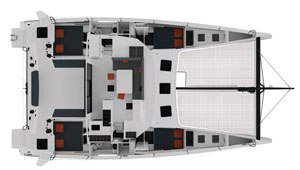
Above: The interior layout options include this four-cabin version and an alternative three-cabin layout with one hull entirely dedicated to the owner’s suite, including an office
Boatspeed broadly matches windspeed at these angles, and you can feel the boat accelerate with each small gust. We are being followed by a media man in a RIB, but they can’t keep up through the waves and are totally drenched. The ease and comfort at which you can sail quickly is certainly unlike any monohull and you immediately understand the appeal of the boat; cruising comfortably at such speed is a dream. The forward hull sections are more voluminous than the 50 or 42 and the boat feels very secure.
The central cockpit area is spacious, sheltered and free from ropes. There is an anchor roller built into the carbon bowsprit, whilst carbon fibre davits come as standard. There is an immense amount of storage under the cockpit seats, in front of the central saloon and in each bow.
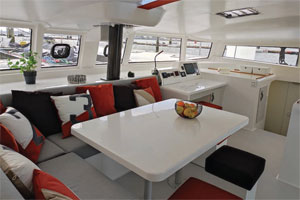
The sailing is essentially done from a one metre long section of the cockpit just in front of the aft crossbeam. There are two winches on the beam at either end of the mainsheet track, the windward winch loaded with the traveller and the leeward winch loaded with the mainsheet. All other sail and daggerboard controls are led to helm stations positioned on either side of the boat, and the arrangement makes sailing the boat practical, simple and intuitive. The only time you need to leave the cockpit is to hoist the sails, with the halyards led to an electric winch at the mast base.
Mainsheet winches that release automatically in an emergency are an option which I would certainly take if planning on any shorthanded sailing for safety reasons. Electric mainsheet and jib sheet winches are an option I would select if racing fully crewed as the forces involved make active trimming of the sails difficult, and pedestal winches would get in the way whilst cruising.
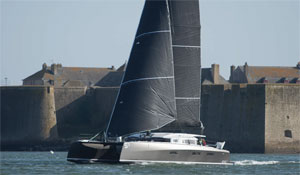
Above: High-volume bows and a new coachroof design give the ORC57 a more muscular look than its siblings. This demo boat has carbon spars, racing sails and a full payload of cruising equipment
Well balanced upwind
As we get further offshore we head upwind at a TWA of around 50° and SOG of about 11kts. By now TWS has crept up to 20kts and the sail charts suggest we should have changed down to the J2, but despite this boat seems well balanced and is very easy to helm. The boat obviously heels less than a monohull, and the central console is clear of the water, but those voluminous hulls do still slam into the 1.5m chop. But with nine people in the cockpit, plus the 4m tender aft under its davits, and not much water in the tanks forward of the mast beam, the boat was a little trim to the stern. The reverse bow can initiate some slam at speed into the chop, but with weight distributon further forward, upwind sailing will be more comfortable for a cruising oriented programme.
‘We wanted to have an outstandingly fast and safe boat on offwind angles, pretty much the way later generation Class 40s are designed for instance, so the design incorporated a lot of volume forward,’ explains Marsaudon Composites CEO Dam Caillliau. ‘Not knowing how it would finish up in the demonstration model, we decided to centre the weight as much as possible. Despite the quite large number of comfort options and equipment incorporated, the first boat is really light. We are already working with the architect to reduce the slamming in short seas and make it more comfortable with a more distributed weight alongside for a more cruising oriented programme, or by considering ballasts in forward hulls to be filled when going upwind, for more performance and racing-type programmes’.
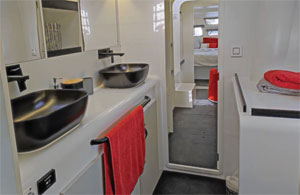
The position of the first reefing point needs adjusting slightly to improve tension in the foot, and Bruno adds this to his surprisingly short to-do list. The boat’s upwind VPPs seem attainable with some further fine tuning, and I have no doubt this team will get the boat set up perfectly for future clients.
It is too early to accurately assess just how fast this boat can be on the racecourse. The ORC42 and ORC50 have been stand-out performers in RORC multihull divisions in recent years, with both proving competitive under a range of multihull rating systems, and there is every reason to believe that the ORC57 will continue the trend. Broadly speaking the ORC42s keep pace with Class40s whilst the ORC50s keep pace with TP52s, so the ORC57 can expect to finish ahead of everyone bar the highest-level grand prix race yachts.

In theory, how fast does it go?
- This VPP study from Marc Lombard is for a loaded sailing displacement of 13,300kg, on flat water
- The boat speeds are calculated for a maximum heel angle limited to 7.6°. This is the angle at which maximum righting moment (RM Max) is achieved
- This value of heel angle corresponds to apparent wind speeds for each true wind angle and each true wind speed noted in the AWS table
- This VPP was calculated using The Wolfson Unit’s WINVPP with the necessary attention to all parameters
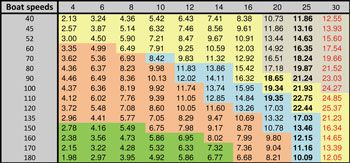




Interior layout
I pass the helm to Eric Levet, here from Marc Lombard’s design office to help with testing, and head inside to check out the interior. The layout is fairly conventional for a multihull, with the bridgedeck living space enjoying 360° views and cabins in the hulls. There is a large forward-facing chart table with excellent visibility which would make a comfortable place to stand a chilly night watch whilst cruising. The L-shaped galley has a large oven, electric hob and Nespresso machine, whilst the lounge and dining area can seat eight in comfort.
Boat number one has the entire port hull reserved for an owner’s suite, complete with a large double bed, plenty of wardrobes, an office space, and an en-suite including a toilet, double sinks and a walk-in shower. There are two more cabins and another toilet / shower room in the starboard hull. It is easy to imagine living aboard on a semi-permanent basis during a multi-year round the world adventure, which is clearly the intention of some clients.
A big effort has been made regarding interior design, with the challenging brief to make the boat more comfortable without adding weight. The floorboards in the hulls are black unpainted carbon fibre whilst the handles of wardrobe doors are made from leather, and such ideas combine to create a unique and stylish yet lightweight interior that is a clear step up in terms of finish quality to the ORC42 or ORC50.
Easy mooring
As I come back outside we are overtaking a (non-foiling) Imoca that is out training, and I doubt they are enjoying quite the same level of comfort. Given the conditions, today is not the day for trying out the bigger downwind sails for the first time and it is time to head in to port. Despite the wind, mooring the boat is surprisingly straightforward, although I’m told this is more complicated in shallow ports where the daggerboards need to be pulled up. The aft swim platform is at a similar height to the pontoon to facilitate stepping on and off the boat.
The boat will soon be sailed close to 2,000 miles two-handed from Lorient to La Grande Motte for the Multihull Show, showing how well the ORC57 is set up for shorthanded sailing. With the right setup the boat could feasibly be cruised by an experienced sailing couple, but equally there is enough space to cruise with four to six guests plus two crew and I’m sure some owners will take this option; this is not a boat for beginners! The IRC rule seems to favour out-and-out racers in the larger size range, so a large cruiser-racer is often not considered an option for people serious about winning the RORC’s offshore races. As such, high-performance catamarans like the ORC 57 might be the best option if you want to cruise in comfort with the family AND have a good go at winning your division in the Fastnet, Caribbean 600 or RORC Transatlantic. An increasing number of inshore regattas in the Med and the Caribbean now include multihull divisions and this versatile boat would be a great choice for them as well.
The base boat costs €1.195m ex VAT in sail-away condition. Marsaudon Composites has an in-house design team and consider their boats to be “semi-custom” and not series builds. The demonstration model, fully kitted out with a carbon mast, carbon cabin top, a high-end suit of Incidence race sails, NKE electronics, a watermaker and a whole host of other cruising extras costs slightly over €1.7m ex VAT, which whilst not affordable for everyone represents very good value for money when compared with other boats of equivalent performance and comfort.
Click here for more information on Marsaudon Composites »
We invite you to read on and find out for yourself why Seahorse is the most highly-rated source in the world for anyone who is serious about their racing.
To read on simply SIGN up NOW
Take advantage of our very best subscription offer or order a single copy of this issue of Seahorse.
Online at:
www.seahorse.co.uk/shop and use the code TECH20
Or for iPad simply download the Seahorse App at the iTunes store


